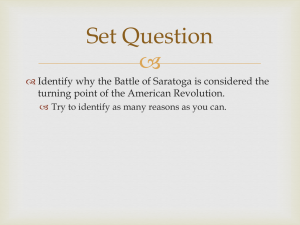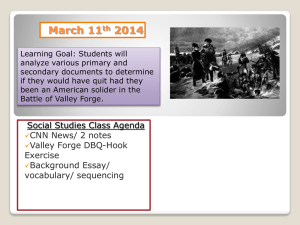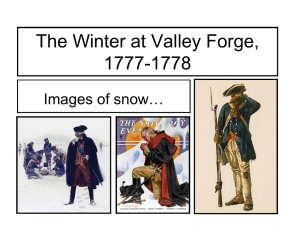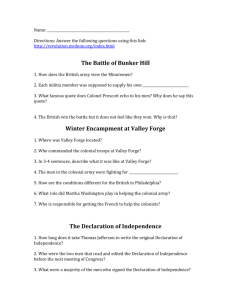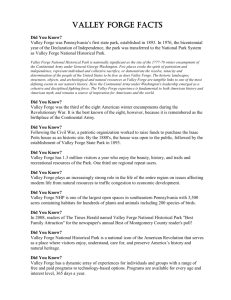The Evans Family of Valley Forge - Tredyffrin Easttown Historical
advertisement
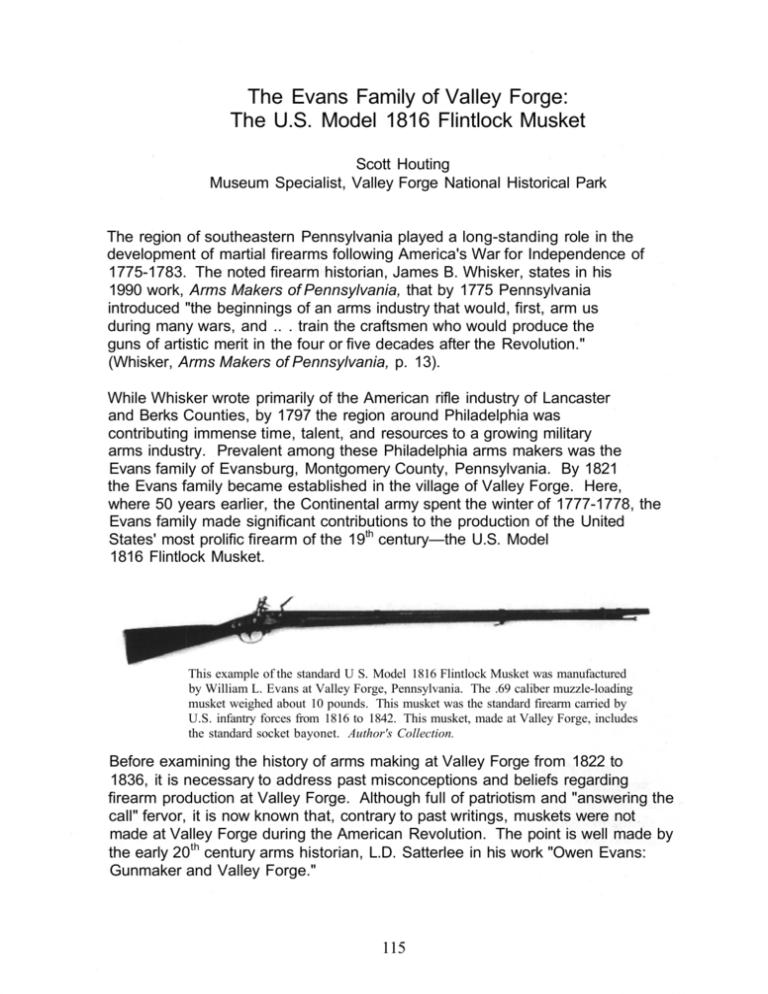
The Evans Family of Valley Forge: The U.S. Model 1816 Flintlock Musket Scott Houting Museum Specialist, Valley Forge National Historical Park The region of southeastern Pennsylvania played a long-standing role in the development of martial firearms following America's War for Independence of 1775-1783. The noted firearm historian, James B. Whisker, states in his 1990 work, Arms Makers of Pennsylvania, that by 1775 Pennsylvania introduced "the beginnings of an arms industry that would, first, arm us during many wars, and .. . train the craftsmen who would produce the guns of artistic merit in the four or five decades after the Revolution." (Whisker, Arms Makers of Pennsylvania, p. 13). While Whisker wrote primarily of the American rifle industry of Lancaster and Berks Counties, by 1797 the region around Philadelphia was contributing immense time, talent, and resources to a growing military arms industry. Prevalent among these Philadelphia arms makers was the Evans family of Evansburg, Montgomery County, Pennsylvania. By 1821 the Evans family became established in the village of Valley Forge. Here, where 50 years earlier, the Continental army spent the winter of 1777-1778, the Evans family made significant contributions to the production of the United States' most prolific firearm of the 19th century—the U.S. Model 1816 Flintlock Musket. This example of the standard U S. Model 1816 Flintlock Musket was manufactured by William L. Evans at Valley Forge, Pennsylvania. The .69 caliber muzzle-loading musket weighed about 10 pounds. This musket was the standard firearm carried by U.S. infantry forces from 1816 to 1842. This musket, made at Valley Forge, includes the standard socket bayonet. Author's Collection. Before examining the history of arms making at Valley Forge from 1822 to 1836, it is necessary to address past misconceptions and beliefs regarding firearm production at Valley Forge. Although full of patriotism and "answering the call" fervor, it is now known that, contrary to past writings, muskets were not made at Valley Forge during the American Revolution. The point is well made by the early 20th century arms historian, L.D. Satterlee in his work "Owen Evans: Gunmaker and Valley Forge." 115 In 1938, L.D. Satterlee set out to investigate the traditional belief that "there was a gun factory at Valley Forge during the American Revolution and whether it manufactured the Model 1777 (French Musket), or any other model." (Satterlee, "Owen Evans: Gunmaker and Valley Forge." p. 1). To support his theory that gun making at Valley Forge during the American Revolution was often based on oral tradition, Satterlee critiqued various sources. His findings were conclusive. Satterlee's investigation first led to the 1910 work of a Mr. Charles Sawyer, Firearms in American History. Sawyer's book concluded that arms were manufactured during the American Revolution at Valley Forge. He based his conclusions largely on firearms found marked "V. Forge" on their lockplate, near the hammer. Today, we know such markings were put exclusively on the 1816 contract musket, the feature topic of this article. For Satterlee, Sawyer's comments lacked clarity, leaving him to question what the author, Charles Sawyer, meant by this statement. L.D. Satterlee continued his investigation of the legend of guns being made at Valley Forge by reviewing the 1916 edition of W. Herbert Burke's Guide to Valley Forge. Founder of the Washington Memorial Chapel, and active collector of Washingtonian memorabilia for the earlier Valley Forge Historical Society, Burke wrote on page 178 of this early park visitor's guide, "Perhaps one reason for the destruction of the forge, by the British is to be found in an old musket in the Valley Forge museum. It was made at Valley Forge in 1777 for the American Army." (Satterlee. p. 1). The musket Burke referred to was a French Model 1754 Flintlock Musket fraudulently marked "Valley Forge." Today, no official records stating gun making at Valley Forge during the American Revolution have been found. In the end, past writings regarding the making of muskets at Valley Forge have resulted in more questions than bona fide evidence. To understand, then, the history of arms making at Valley Forge, the author submits that the story begins with the infancy of military arms making in the United States in 1794. In 1794, the young United States found itself on a course toward war with France. To counteract the French threat, on 2 April 1794 the United States Congress passed a resolution, that among other things, authorized the establishment of two national armories to make weapons for the United States infantry. The two armories were located at Springfield, Massachusetts and Harpers Ferry, Virginia (later in 1863 in West Virginia). The following year, 1795, Congress adopted an old workhorse of America's War for Independence, the Model 1763 French Flintlock Musket as a pattern for the United States' first standardized military musket. Known as the Model 1795 U.S. Flintlock Musket, production began at Springfield Armory the same year. Along with the adoption of the 1795 musket, the military initiated further research and development programs at the two national armories designed 116 to refine and improve the standardization of the musket. By July 1815, the U.S. Ordnance Department moved closer toward an improved standardized musket. In a letter of June 10, 1815, Colonel Decius Wadsworth of the Ordnance Department wrote the Secretary of War, Alexander Dallas, noting several points which should be considered when designing a new pattern musket. The specifics of this 1815 letter are not important to this brief essay. What is important to understand is that through this letter, the U.S. Ordnance Department designed, approved, and manufactured a new gun, the U.S. Model 1816 Flintlock Musket, which became the most prolific and dependable infantry firearm for the nation's military from 1816 to 1844. Some sixteen independent and private contractors, including the Evans family, augmented the nation's two national armories in the production of the U.S. Model 1816 Flintlock Musket. At this point, we channel our focus to Valley Forge. After America won its independence in 1783, the iron industry at Valley Forge slowly declined as a profitable business. By 1802 a slitting mill once operated on the west side of Valley Creek was idle. The last forge at Valley Forge was in ruins by 1816. At this point, Mr. John Rogers, an iron industrialist from Philadelphia, purchased land on the west side of Valley Creek, setting the stage for firearms manufacturing at Valley Forge. The Upper Merion 1814 tax rolls include an assessment on seventy-five acres of land owned by John Rogers located along the west, or Chester County side, of Valley Creek. (Microfilm. Montgomery County Historical Society, Norristown, PA). Listed with John Rogers is Mr. Joshua Malin of Upper Providence in Delaware County. Apparently shortly after the 1814 purchase, Malin, a cousin of Rogers, rebuilt the dilapidated slitting mill on the west side of Valley Creek. This structure, rebuilt to Malin's specifications, measured eighty feet long by thirty feet wide and was complete with a "tilt mill" at one end and a small foundry between the main building and the dam. This refurbished structure, it is now believed, became the factory where the 1816 contract muskets were manufactured at Valley Forge. The first documented government contract for muskets made at Valley Forge originated in Richmond, Virginia. On July 28, 1817, Mr. Alex McRae of Richmond, signed a contract with the U.S. Ordnance Department to supply 10,000 muskets, of 1816 pattern, at $14.00 each. Unable to fill his obligation, McRae's contract was terminated "having failed to deliver arms, according to the terms of his contract, a suit was instituted against him and his sureties, in July, 1820." (A Collection of Annual Reports... To The Ordnance Department, Volume I. p.113). The contract was transferred to John Rogers and Brooke Evans of Valley Forge, Pennsylvania. "It may be proper to remark, that the contract with Alexander McRae, of Virginia, made July 28, 1 8 1 7 , . . . has been, with the consent of the Department, transferred to John Rogers and Brooke 117 Evans, of Pennsylvania." (Ibid). With this transfer, the first documented firearms contract at Valley Forge had been approved. Brooke Evans, who migrated from Sheffield, England, was a Philadelphia hardware merchant whose business was registered at 120 High Street. Official records state from March of 1821 to December of 1823, Evans and John Rogers manufactured "Under this agreement, five thousand seven hundred and thirty muskets, of approved quality, have been delivered; and no doubt is entertained of its being satisfactorily fulfilled within a short period." (Ibid). The partnership between Brooke Evans and John Rogers then dissolved, John Rogers entered into a lone contract with the government for an additional 5,000 muskets. This second contract for the Model 1816 musket was awarded to John Rogers on January 2, 1825, for 5,000 muskets at a price of $12.25 each. The delivery rate was set at 1,000 stands per annum. (Gluckman, American Gun Makers, p. 183). Each stand consisted of a musket, bayonet, and musket tool. John Roger's contract for 5,000 muskets introduces a third player into the history of firearms manufacturing at Valley Forge. Unable to get into production for lack of capital, Rogers apparently entered into a partnership with William L. Evans of Evansburg, Montgomery County. William was the sixth child of another known Pennsylvania musket maker, Owen Evans. He was born on May 28, 1797 in Limerick Township, Montgomery County. By late 1825, William L. Evans, partnered with John Rogers, began production at Valley Forge on the U.S. Model 1816 musket. Records generally agree that William completed the contract for 5,000 muskets over the next three years. Known muskets from this contract are dated from 1826-1828 on the musket's lockplate behind the hammer. (Flayderman, Flayderman's Guide to Antique American Firearms . . . and their values, p. 436/ On May 3, 1831, William L. Evans was awarded a second, and final, government contract for the U.S. Model 1816 Musket. This contract for 1,500 muskets, at a price of $12.45 per stand, was to be delivered within two years to the Frankford Arsenal in Philadelphia. Surviving muskets of this contract, the last documented government arms contract at Valley Forge, support the belief that all 1,500 stands were delivered. By the closing months of 1833 firearm manufacturing at Valley Forge neared completion. When an 1844 flood of Valley Creek washed out the former mill of Evans' musket production, the factory was not rebuilt. The once active musket manufacturing business at Valley Forge was over. Family genealogical records indicate that William L. Evans died on August 6, 1861. William's body "is buried in the family 118 plot in the old churchyard of St. James Perkiomen Church at Evansburg." (Gluckman, p. 61). This close-up photograph of the Evans contract Model 1816 Flintlock Musket lockplate clearly shows the stamped markings. Stamped forward of the cock (hammer) is "W.L. Evens" followed by an eagle and "V. Forge" for Valley Forge. Behind the hammer note the date "1826" and stamped "U.S." Author's Collection. A few final thoughts will complete this study of firearms manufacturing at Valley Forge. Firearms historians generally agree that gun manufacturing at Valley Forge was part of a larger picture. It is believed that the barrels and other iron components of the Evans' 1816 contract muskets were made at Valley Forge. These parts were then crated and shipped to a factory in Evansburg, near Collegeville, Pennsylvania, where the actual muskets were assembled. Arcadi Gluckman, and his co-author L.D. Satterlee comment in their work, "It is believed that barrels mostly were made at Valley Forge, the rest of the arm being made at the factory at Evansburg." (Ibid. p. 61). This factory, possibly located at Pechin's Mill, south of the Perkiomen Bridge, was the established mill operated in previous years by Owen Evans, the father of William L. Evans. It should be noted that this work is not the definitive study of firearms production at Valley Forge. To date, the lack, or unknown existence, of government records related to musket production at Valley Forge leave the subject open to continued research. The actual location of the mill along Valley Creek within Valley Forge National Historical Park is speculation at best. (To date, archeological survey records do not locate the exact location of the mill.) The author continues his research into the intriguing story of firearms manufacturing at Valley Forge. 119 WILLIAM L EVANS Section of a page from the original 1831 Ordnance Department contract with William L. Evans of Valley Forge, Pennsylvania. This contract, dated 3rd May 1831, was the last contract with William Evans. The muskets covered by the contract were delivered by 1833. Courtesy National Archives, Record Group 156. Sources Consulted: A Collection of Annual Reports and other Important Papers, Relating to The Ordnance Department. Vol. I: 1812-1844. Washington, DC: U.S. Government Printing Office. 1878. Flayderman, Norm. Flayderman's Guide to Antique American Firearms... and their values. 5th Edition. Northbrook, IL: DBI Books. 1990. Gluckman, Arcadi. American Gun Makers. Harrisburg, PA.: The Stackpole Co. 1953. Montgomery County Tax Assessment-Upper Merion Township (microfilm reel for 1789-1844). Montgomery County Historical Society. Norristown, Pennsylvania. 120 Satterlee, LD. "Owen Evans: Gunmaker and Valley Forge." Hobbies. October, 1938. Whisker, James B. Arms Makers of Pennsylvania. Selinsgrove, PA: Susquehanna University Press. 1990. This article summarizes a program presented by the author to the Tredyffrin Easttown History Club in May 2003 on military firearms production at Valley Forge. Frankford Arsenal, Philadelphia in 1832 at the time William L. Evans delivered his muskets according to his 1831 contract with the U.S. Ordnance Department (see the 10th line in the partial reproduction of the contract above). The arsenal was established in 1815 but not entirely completed until 1831. It consisted of six large stone buildings and two small workshops, forming a square, besides a magazine and gun shop. Saturday Evening Post, April 7, 1832. 121
